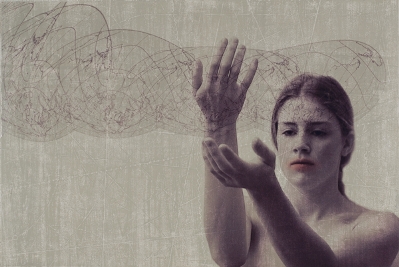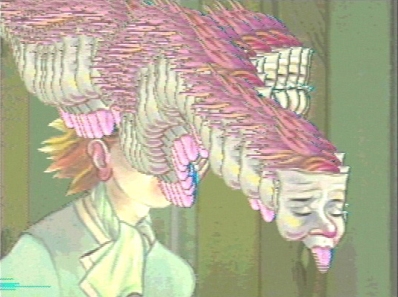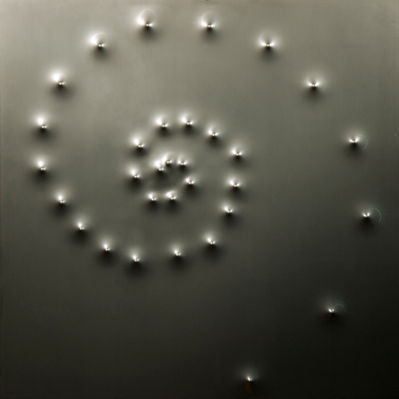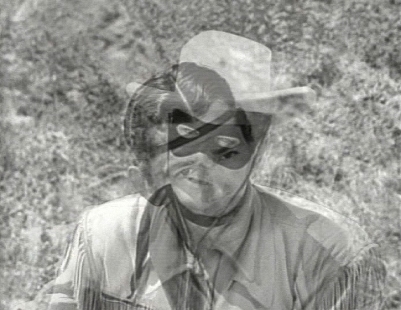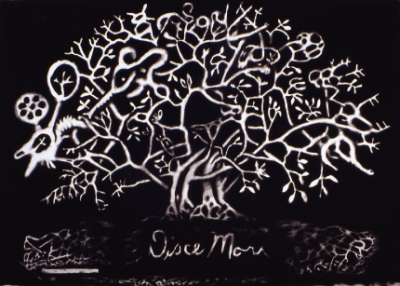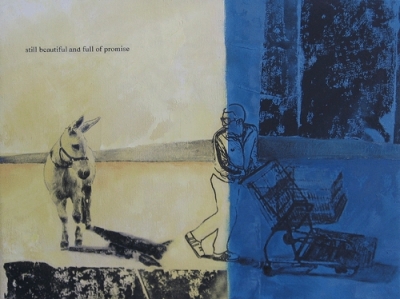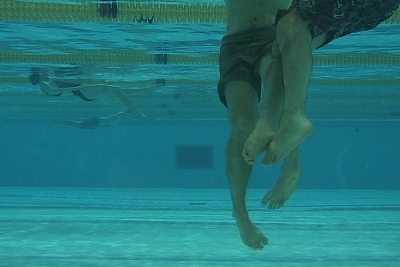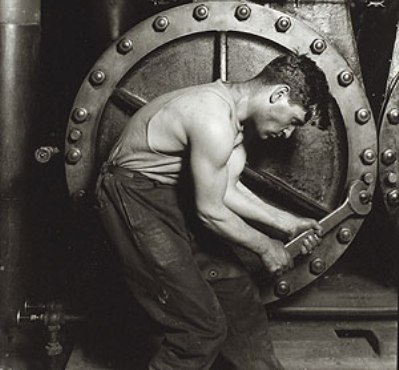Things of Desire Issue # 6
September 25, 2008
Sup ToD homies! I hope you all have had the chance to dry-clean your favourite festival-going attire, because this week kicks off the fall festival season. This week we bring you coverage from Edmonton’s print international, Toronto’s ImagineNative film and media art festival, and a selection from Halifax’s Photopolis along with a smattering of non-festival exhibitions from across the country. If you like what you see send us some love by becoming a subscriber and email thingsofdesire@gmail.com. Enjoy!
—Mike Landry
Edmonton Prints
September 25, 2008
By Mike Landry
Last week a crate failed to arrive for installation at the Edmonton Print International 2008. There was some concern given EPI had paid the airfare for the Finnish artist, Annu Vertanen, to install the wall-sized piece. Since the competitive international exhibition is organized by the non-for profit Society of Northern Alberta Print-Artists (SNAP), such a bust would tough.
The crate eventually showed up, and was installed in record time. The scare was just one of many pieces that have fallen into place to make the exhibition a reality. After five years of work, Walter Jule, the general secretary for EPI 2008, says they’re ready to present a show that stands up in international print community.
“Our byline for the show is ‘A Celebration of the Printed Image,'” says Jule. “We just want to show Edmonton this is the breadth of what’s going in contemporary print expression around the world, and ask what do you think.”
Beatrice’s Centre for Student Affairs
September 25, 2008
By Mike Landry
Jennifer Cherniack almost didn’t want to be quoted as saying so, but one day she wants to move back to Winnipeg.
“My most complicated relationship in life is with Winnipeg. There’s something about the city that I can’t get away from,” says Cherniack, assistant curator/public programmes manager with Toronto’s InterAccess Electronoic Media Arts Centre. “People ask me where I’m from I tell them I’m originally from Winnipeg but I live in Toronto. It’s always like I’m a visitor somewhere else.”
Cherniack’s interest for her hometown inspired her to curate Beatrice’s Centre for Student Affairs, or, How I learned that my mother was right about making art in a prairie town during the rise and fall of grunge music. Using works from Winnipeg-born artists Daniel Barrow, Jo-Anne Balcaen and Evan Tapper, Cherniack presents an exhibition about art school, coming of age stories, gossip and forced reunions.
Trauma Sutra
September 25, 2008
By Mike Landry
Taking aim with his father’s .357 in hand Newfoundland artist Raymond Roddick had an epiphany.
He had just returned home from a four month Buddhist retreat where the monks reminded him constantly to focus on his breathing. And here he was out shooting with his dad who was reminding him to pay attention to his breathing. And suddenly things clicked.
“There was a connection between these two things—they both have to do with concentration, focus and stopping in a bunch of different ways. I just jumped in at that point,” says Roddick. “The only idea was to make a mark [with a gunshot] and not penetrate the surface completely to make a very small sculpture.”
The Minas Basin Project
September 25, 2008
By Stacey Ho
Geri Nolan-Hilfiker tells me about the Minas Basin. She knows it well. Chatting over the phone, she tells me about this little spot in the Bay of Fundy, its history as a shipbuilding site. She talks about the area’s natural history, with its deposits of slate, gypsum, basalt, amethyst, old dinosaur bones. She’s picked up some of this knowledge through photographing the basin, but Geri’s lived in the area for years, clam digging along the beaches with her parents as a child.
Given a Nova Scotia projects grant, Nolan-Hilfiker spent the summer of 2005 shooting 75 rolls of film, views of the Minas Basin, looking out from the coastline towards the sea. The result is 50 images, opening this week as part of the Photopolis Photography Festival. The original idea for the project was to take photographs at ground level, the level of the sea, but given that the area has the highest tides in the world, it didn’t matter in the end if the camera was on sea level.
“It just didn’t become that important in the end. I went wherever. ‘Oh here I am at high tide! Oh this is low tide, this is interesting.’ It’s more fun to be intuitive.”
Dancing with Wolves
September 25, 2008
By Mike Landry
Like a woman involved in an abusive, the relationship between Hollywood and North American Natives is a little bit more than complicated. Up-and-coming curator, and native Mohawk, Ryan Rice focuses examines this relationship in his new exhibition HOW: Engagements with the “Hollywood Indian.”
Using a eight artists, Rice depicts Hollywood as something Natives both despise and aspire to. He refers to Jay Silverheels, who played Tonto on the Lone Ranger as “the quintessential ‘Hollywood Indian.'” Although Silverheels was the first native person to land a major role that role was a stereotype.
“It’s a push and pull kind of thing. We hate Dances with Wolves, but we love Dances with Wolves,” says Rice. “It’s still pretty much a white movie, with Kevin Costner and his Indian woman who’s actually a white woman and we’re the background. But if you go across Canada or North America everyone on the reserves will have a copy of Dances with Wolves.”
One Hip Squeegee Kid
September 25, 2008
By Mike Landry
Saskatoon-based painter Robert Christie is neither young nor hip. He likes to think he might have been years ago. But just because he’s not an cool-kid hipster anymore doesn’t mean his art isn’t cutting edge.
“You always want to push your work, which is why I move from series perhaps more than a lot of people do,” says Christie. “The endeavor is to make it new and fresh for me. If they’re modern or fresh, I hope they’re that at least, and that they offer a viewer some new substance on admittedly something that has been around a long time.”
You can call him Mr. Organization. It’s taken Christie four decades to assume the moniker, but his latest series of paintings bear the fruits of his effort. Before placing a drop of paint on his canvas Christie has started using gel to organize the layout of his painting. After he’ll add the occasional shapes, but he won’t change too much. With bulk of the painting determined, Christie is ready to deal with his real challenge.
Mark Adair’s Last Garden
September 25, 2008
By Mike Landry
Before visiting Things of Desire, Toronto artist Mark Adair had never been to a blog before. At 53-years-old, Adair is finding himself connecting more and more with contemporary themes through his work.
Preoccupied with what he calls, “old man’s concerns,” his new exhibition Last Garden connects his personal reflection on the end of his life with environmental activism. After a good friend died a few years ago, along with her garden die he was tending to, Adair began to reread Rachel Carson landmark eco-activism book Silent Spring.
“You know when I was younger I was only concerned with the environmental stuff, I was a real active environmentalist,” says Adair, “but now that I’m older it all kind of gels together—it’s the end of my own life and you do see this kind of unbelievable practice going on around the world and it gets kind of defeating I guess.”
Regeneration from Regina
September 25, 2008
As an art student at the University of Regina multimedia artist Joan Scaglione spent months working with raw wool on a wall. Eventually, frustrated and fed up with her studio space at the university, she brought the wool home into her basement. She shut the lights off and began to wrap herself in the wool.
“I felt like I was crawling out of one of the primal interior space of life—this cocoon shaped habitat,” says Scaglione. “That really triggered in me an awareness of interior versus exterior space— both architecturally and metaphysically.”
Scaglione’s newest and evolving work, Regeneration, continues this exploration. A combination of video, natural material and constructed objects, Regeneration looks at the dialogue between nature and consciousness. Scaglione believes in order to reverse ecological destruction we must first regenerate our imaginations.
Rearing Art
September 25, 2008
By Mike Landry
You don’t need to visit People Magazine‘s Celebrity Baby Blog to know that motherhood is in -but it sure is worth checking out just for its creepiness. Baby bumps and little munchkins have been tabloid fare for years now. And BC artist Yoko Takashima says it’s only fitting to read about pregnancy in trite tabloids.
“It’s weird the fact that it’s become a popular issue, because it’s not a popular thing. It has been done for centuries,” says Takashima. “Now people are talking about this special thing, but it doesn’t have a citizenship in a contemporary societal world because it’s a trivial activity. It’s not a big deal activity. Instead of talking about that trivial thing [intellectuals] talk about other issues.”
Although she’s investigating the social and political aspects of motherhood, Takashima says she isn’t a feminist. She’s just a mom who happens to be a contemporary artist. And she explores her relationship between the two in her new exhibition, Blend.
Things of Desire Issue #5
September 18, 2008
Greetings ToD friends! This week we here at ToD are super excited for the official beginning of the Fall arts season. As the leaves start falling it’s time to get gallery hoping. And we’ll be here to guide you from gallery to gallery, so subscribe to Things of Desire by launching an email to thingsofdesire@gmail.com to make sure you know what’s the happy-haps. Enjoy!
—Mike Landry
Seth’s North Star Talking Picture House
September 18, 2008
By Mike Landry
When Seth picks up his phone after a few short rings, the bell inside his rotary phone can be heard still faintly pitching its antiquated tone. The phone, like the Guelph-based cartoonist’s fictional city, Dominion, is typical of Seth’s anachronistic nostalgia-laced style.
This melancholic take on the modern city is taking Waterloo by storm this week. University of Waterloo’s Render Gallery presents Seth’s model Dominion City, complete with new Hall of Records style faux documents. And the Kitchener-Waterloo Art Gallery has built a new functional life-sized model of Dominion’s theatre.
“I tend to think small I work in a studio I’m a cartoonist I never think of doing anything large so it was an interesting opportunity for me,” says Seth. “It’s a lot bigger than I imagined. I made plans so people could build it, and even though I put measurements still, somehow, I didn’t imagine it being bigger than a garden shed.”
Lamentations in a Winter Garden
September 18, 2008
By Stacey Ho
At Montreal’s Cabot Square, Deborah Margo and Devora Neumark are organizing some unusual singing lessons. In a park celebrating the European colonization of Canada, immigrants and refugees will be sharing their mourning songs. During the course of six sessions, Neumark and Margo hope to create a public space for dialog and reflection in a project titled Why should we cry: lamentations in a winter garden.
“The notion of singing is something everybody can do. It’s not about having a beautiful voice. It’s about what can happen when people sing together.”
In a spirit of inclusiveness, the two artists have sought out teachers from a wide range of communities and experiences. Accompanied by a drum, Pierre Junoir Lefevre is leading the first session on September 21, sharing traditional mourning songs from his native Haiti. Considering the recent hurricane as well as the police shootings in Montreal’s Haitian community, these processional songs in French and Creole hit especially close to home.
Measure your Morals
September 18, 2008
By Mike Landry
Calgary artist Jane McQuitty used to think modern taste was natural. It seemed to her we were hardwired to enjoy things that are restrained and true to material.
After some reading she was shocked to discover just how culturally loaded out taste is. During the Victorian era, one’s taste became irrevocably linked to one’s moral standing. Good morals led to good taste, which would become the hallmark restraint of modern aesthetics. McQuitty’s just not to sure if she’s buying it anymore.
“That’s a cultural artifact, and I think we live in a cosmopolitan society now. I’m interested in sampling Calgarians and seeing where they fall on this,” says McQuitty. “Do they like the more elaborate and sensual work, or do they like the sort of minimalist daylight lit version. I would just like them to articulate that a bit for me.”
Jen K Wilson’s Mysterious Guests
September 18, 2008
By Mike Landry
With a four-month old baby boy to occupy her time, Toronto-based artist and new mommy Jen K Wilson hasn’t had much time to work. But her new series Mysterious Guests has become a lot more important.
Using drawings, photographs and imagery taken from catalogues and other sources Wilson produces photocopy transfers which she incorporates with oil painting to create a visual narrative. In Mysterious Guests, Wilson addresses her interest in vegetarianism and animal rights.
“I had produced a series of paintings called Dreams of Barbarians, which was very abstract and focused primarily on the meat industry. With Mysterious Guests, I aimed to produce work that would be more accessible to a wider audience, as well as exploring some new territory, both thematically and technically,” says Wilson.
Richard Deschênes’ Reproductions
September 18, 2008
By Mike Landry
Movement and suspension; big and small; figurative and abstract—Montreal artist Richard Deschênes newest series, Reproductions, creates poetry in opposition.
“In general all of my work is like the opposition between movement and suspended action. It’s about time, scale, and the process of how to build an image,” says Deschênes.
Although a mix of large 7×9 foot paintings and other smaller works, Deschênes also used small found images and blew them up to a obscurely large scale. Most of the images are from an old encyclopedia collection. Deschênes enlarged images that were two inches big to as three to five feet.
Artist-Run Decentres
September 18, 2008
By Mike Landry
After eight book launches across Canada for Decentre: concerning artist-run culture, managing editor Robert Labossiere is exhausted. Considering Decentre is the only book of its kind in Canada, there’s a lot of people looking to check it out.
“There have been in articles in magazine and occasionally book anthologies that have tried to deal with what is an artist-run centre,” says Labossiere. “But early on we decided we weren’t going to do a book that was going to be an in depth analysis, or a compilation of those essays. That would make an interesting book in itself but that’s not this book.”
Shying away from the overly academic, Decentre features about a hundred contributors writing anywhere from 7 to 1000 word pieces. Labossiere and his editorial team provided contributors with a few questions to get them thinking, and most went off on their own tangents.
Make Rugs Not War
September 18, 2008
By Stacey Ho
When war is a part of everyday existence, it also becomes a part of everyday culture. Driven out of home villages and encountering urban areas for the first time, mixing with disparate groups in refugee camps, Afghan weavers reflect the shared experiences of a country that has been a war zone since the Soviet occupation.
Battleground: Afghan war rugs brings together 118 rugs that reflect the lives of people cut off from Western media coverage. For curator Max Allen, the rugs, taken together, show a radical and disturbing shift towards modernity.
“The war is so spectacular and horrific,” he says, “that [weaving] traditions have been broken, except for technique. Representational tradition is broken, or exploded I guess is a better word.”
If it ain’t Broke…
September 18, 2008
By Mike Landry
Seeking comfort in company, a group show between Winnipeg artists Christian Worthington and Patrick Neufeld was inevitable. Relics in a postmodern age, the artists share a deep theological concern in their art.
“If you see the show in person it becomes pretty obvious why the two of have a show together, because there’s just an old master consciousness to the images,” says Worthington. “You don’t do something once and then forget about it. Culture is built up by taking things of value and restating them over and over, every day”
Worthington’s traditional-styled paintings and Neufeld’s restrained print and encaustic works had made them aliens in a scene constantly seeking originality. On its own their work had a veneer of irony. Together the seriousness of their projects becomes apparent.
From Fabrics to Flowers
September 18, 2008
By Mike Landry
After 15 years, Toronto-based artist Sally Ayre was ready for a change. She had made a name for herself using old photographic processes on translucent fabric that she would then layer to create images on images.
Replacing the fabric for the similarly translucent and textured Japanese paper Ayre set out to learn screen printing at Toronto’s Open Studio last Fall.
“You can only push a way of working so far and you need to shake it up a little bit,” says Ayre. “You get to a point you’ve really done all you wanted to do, and you don’t want to become redundant.”
Shooting Darkrooms with Digital
September 18, 2008
By Mike Landry
According to wikitravel, West Africa’s last surviving giraffe herd can be found just 45 minutes outside of Niamey, Niger. But when Montreal photographer Michel Campeau visited the French-African capital he was interested in another at-risk species—darkrooms.
Campeau’s latest project is a continuation of a book he published focusing on darkrooms in the Montreal area. Expanding his scope, he’s now working on a sequel that focuses on darkrooms around the world.
“After working for 35 years in darkrooms I finally decided to look at them,” says Campeau. “My project is about the photographic decline and the disappearance of the darkroom. That’s the reason I wanted to look at them, because they’re slowly disappearing everywhere.”
Things of Desire Issue #4
September 11, 2008
Ahoy hoy! I hope you are loving your now weekly dosage of Can-alt-art news. Sadly, I must admit I was remiss in my initial claim to cross-Canada art coverage. I had been terribly overlooking poor Saskatchewan. But thanks to CARFAC Saskatchewan the problem has been fixed. So, look forward to hip art coverage from Weyburn to North Battleford. And don’t forget to subscribe to Things of Desire by launching an email to thingsofdesire@gmail.com. Enjoy!
—Mike Landry
Amplified Intimacies
September 11, 2008
By Stacey Ho
Virtual reality, today, is everyday experience. Far from science fiction, technological interfaces mediate how we talk, play, and learn.
Amplified Intimacies, an upcoming group show by Interstices, explores how these new technologies shape and change the way we get along. Formed in 2000, this creative, academic group began, appropriately, out of a need to communicate about new media.
“Games are such a huge thing now,” says Lynn Hughes. “They dominate the entertainment market, and yet art schools don’t deal with them.”
Six Decades of Bruce Head
September 11, 2008
By Mike Landry
When the Winnipeg Art Gallery first decided to hold a five decade retrospective exhibition of seminal local artist Bruce Head the artist only had one problem—he was into his sixth decade of work.
So, Head called up Winnipeg’s Ken Segal Gallery, and arranged to have his sixth decade shown simultaneously with his fist five. Not that all of Head’s most recent works are new. Half of them are works he started 15-20 years ago with “tremendous possibilities.”
“I’ve never shown everything I’ve got. Over the years when my contemporaries were going to Europe and that, I was raising five kids and didn’t go anywhere,” says Head. “I had the space to keep it and ended up accumulating a hell of a lot of work.”
Second Hand Records
September 11, 2008
By Mike Landry
American singer Anita Bryant may be a devout Christian and anti-gay crusader, but it’s nothing that Winnipeg-based artist Suzie Smith can’t fix. For her latest project, Second Hand Records, uses silk-screen techniques to mask off and add new images to second hand record covers.
Covering up Bryant’s crucifix chain and the bible she clutches on the cover for her 1962 album, Abiding Love, Smith then surrounds Bryant with menacing dark clouds to create a whole new meaning from the original.
“The project is about communication and media, by what you choose to reveal and what you choose to conceal can say a lot, and you can totally reinterpret that,” says Smith. “It’s almost more like when you’re a little kid and you draw a mustache on something. It’s just taking it further and making a backwards collage of sorts.”
The Swimmers
September 11, 2008
By Mike Landry
Montreal-based photo/video artist Christophe Jivraj’s doesn’t like to refer to the people featured in his work as subjects. They’re his clients, and, more importantly, his friends.
They’re also students at the Centre d’Activitief Recreatif et Educatief (CARE), in Montreal’s NDG—a school for cognitively lucid and severely physically disabled adults. Jivraj has been photographing and working with them for three years. For his latest work, The Swimmers, is an atmospheric video taken underwater of them swimming.
“Creating this video installation was more like trying to put other people into my shoes and see how beautifully bizarre everything I do with them is,” says Jivraj. “You see these bizarre bodies floating around you, you do get sensorally challenged. You feel like you‘re under water, and you feel the weightlessness. But then you see the bizarreness, and the terrifying tranquility of all of it.”
Tony Scherman’s Intimate Drawings
September 11, 2008
By Mike Landry
In a 2007 interview published in Border Crossings, Robert Enright referred to the work of Toronto painter Tony Scherman as, “the everyday raised to the level of the monumental.” How fitting it is then that Scherman’s latest exhibition Intimate Drawings focuses on his daily drawings culled from his drawers.
The exhibition was conceived as being something less formal in nature. And rather having any overarching theme, the show is just about drawing. He says if the show has any meaning it will be in the drawings.
“Drawing is kind of like playing scales in painting,” says Scherman. “Drawing is contingent. The paper’s already lit and I’m just passing through. The arrow of time only goes one way in drawing; once you’ve used up all the light you’re done.”
Beaver Tales
September 11, 2008
By Mike Landry
Living in Downtown Toronto it’s hard to relate to the stuff of Canadiana iconography. Heck, I couldn’t tell a maple leaf from an oak leaf. And yet images of beavers, moose, and other iconography are everywhere.
To illustrate why these images are so pervasive Rachel Gotlieb and Martha Kelleher in their exhibition Beaver Tales: Canadian Art and Design have brought together more than 100 pieces from artists, designers, and craft makers working over the last two centuries. The exhibition threads together souvenirs and Emily Carr by their consistent use in Canadian flora and fauna up to today.
“We’ve just taken them for granted. We look at the quarter and say yup and flip it over the counter,” says Kelleher. “This exhibition may be a way, I hope, to show these iconic images are meant to be important to our culture and our country.”
Saved Paradise
September 11, 2008
By Stacey Ho
Took all the trees, put ’em in a tree museum/ And they charge the people a dollar and a half just to see them. Like the song it takes its name from, The Tree Museum celebrates a spirit of environmentalism, acting as a haven for both nature and culture.
For the past eleven years, this 200-acre area in Muskoka has hosted an annual exhibition of site-specific works, featuring both emerging and internationally renowned artists.
“The first year, there was no road. We had to walk in with tools,” says EJ Lightman. “The second year, the Tree Museum’s house was built on the original foundations of a farmhouse, but we had the opening in the garage.”
On a Sunnyside Mourning
September 11, 2008
By Mike Landry
Home to the roller coaster with the “dippiest dips on of the continent,” Sunnyside Amusement Park was once Canada’s Coney Island. People would flock to Toronto’s then affluent Parkdale neighbourhood for its beach, restaurant and dancing.
Standing on the corner of Ronscavalles, King and Queen Street West with the noise from the Gardiner Expressway and the streetcar depot it’s hard to imagine Sunnyside ever existed. Torn down in 1955 to make room for the Gardiner Expressway, only the Sunnyside Pool and Bathing Pavilion and the Palais Royale buildings survive as relics. But one site-specific performance piece, On a Sunnyside Mourning looks to resurrect the park.
“The park stood as a beacon for the development of Toronto, and sadly no one really knows much about this park at all anymore. Mainly because no one ever goes down to the waterfront anymore,” says Laura Mendes, co-head of Toronto’s Labspace Studio and performance participant. “The Gardner hasn’t just severed our relation to the waterfront, it’s severed its history.”
Marginalia Math
September 11, 2008
By Mike Landry
Veteran performance artist Margaret Dragu isn’t used to having so much stuff. Fabrics, paints, threads and artwork litters her home. And she can blame visual artist Pam Hall for that.
The pair have been cooperating on their project Marginalia Math for almost five years now. With Dragu in BC and Hall in Newfoundland the pair keep daily email contact and have sent more than a thousand art squares across the country.
“We called them memory clothes because they’re about our day to day history that we share with each other,” says Dragu. “Each square was representing one foot, like one step of us trying to walk together. So in a way we were creating a path or a railway to each other with each of these fabric squares.”
Shelley Mansel’s All That
September 11, 2008
By Mike Landry
In She’s All That, the 1999 remake of Pygmilion Freddie Prinze Jr. stars as the high school hunk who bets he can turn any girl into Prom Queen. Lucky for him his “nerdy artist” is Rachael Leigh Cook who takes off her glasses, lets down her hair and changes from paint-stained overalls to pretty dresses. It’s this same “challenge” that Halifax-based artist Shelley Mansel embarked in her latest painting series, Urban Cathedrals, of warehouses and buildings under construction.
In the series Mansel has taken typically unappealing images and challenged herself to find the beauty in them. Fortunately for her, and Mr. Prinze Jr., the beauty is naturally there—in the linear and graphic qualities of the images she used as models.
“I’ve been dealing with modernization in my work a lot, but in a seductive way so that it’s a double-edged painting,” says Mansel. “You can read it two ways: either as a seductive view of modernity, or as a parasitic element of modernity.”
Blood, Sweat and Art
September 11, 2008
By Mike Landry
It’s easy to dismiss the 19th century from our everyday lives. It was an era of Napoleonic wars, slave trading and the wild west. But it also was an era that saw the invention of the bicycle, stethoscope, refrigerator, vacuum cleaner and modern computing.
The exhibition Blood, Sweat and Tears: Labour in Art at the Art Gallery of Hamilton aims to show how the 19th century is still alive today. Providing visitors with not just beautiful art from the 19th to the mid-20th century, the show also intends to provide a greater sense of history.
“We’re still continuing that trend of total transformation, which we first saw in the 19th century in industry and the move away from agriculture and the market,” says Dr. Patrick Shaw Cable, who curated the exhibition. “As a person working in an office for a big computer firm it might be interesting for people to be reminded in this day and age who’s making all the money for these workers.”
Things of Desire Issue #3
September 4, 2008
Howdy! Welcome to the third issue of Things of Desire. The big change this week is that the blogzine is now and forever will be (hopefully) a weekly venture. So you can rest assured every Wednesday night that a brand spanking new issue will be online when you wake up. As always, if you haven’t already subscribed to Things of Desire you can do so by firing off an email to thingsofdesire@gmail.com. Enjoy!
—Mike Landry
Postcards from the Void
September 4, 2008
By Mike Landry
In the city of Kitchener, where Aleksandra Rdest grew up, roads didn’t have ends. So when the visual artist was told to take “the road into town,” head to the end and go to the house across from the convenience store, she couldn’t help but feel a little scared.
“I was like number? Street name? No,” says Rdest. “I didn’t really know what I was getting into going out there. I had a kind of idealized notion of what small town life would be, and it was very quaint but the reality wasn’t so.”
That was last Spring when Rdest first made it to the end of the road to Pouch Cove, about 20 minutes outside of St. John’s, Newfoundland. Rdest has returned from the artist in residency program and she brought a new series of work called, Postcards from the Void with her.
In Tandem and in 3D
September 4, 2008
By Mike Landry
As if painting in tandem for Calgarians David Foy and Jennifer Saleik wasn’t difficult enough, they’re beginning to work with sculpture. Dave & Jenn’s latest series, In Which They Find Themselves Between Here and There, showcases their new double-sided paintings on plinths and their 14-foot-wide painting with 3D elements.
“Our interest in painting has always been in how we can mess with the basic ideas of [painting],” says Saleik. “It’s dangerous when any person who’s used to doing two-dimensional things tries to muck around in 3D. We’re painters not sculptures, and sometimes we can be painfully aware of that.”
Self-described landscape artists, Dave & Jenn have spent the past four years crafting a narrative that combine inner mythology and historical documentation. Their new work looks to refine this new world they’ve created.
Shedding Light on Building
September 4, 2008
By Stacey Ho
Condominiums, hospitals and art galleries are all places that are, for one reason or another, sterile environments. Their emptiness makes them funny, awkward structures for people to do human things in.
Placed in such an environment for a residency at YYZ, artist Swintak spent the summer dealing with awkward, empty space. Her solution? Take a genuine countrified shed and transpose it into the gallery.
“It sort of looks like it dropped from the sky, or appeared there a la Wizard of Oz,” she explains.
Group of Seven Awkward Moments
September 4, 2008
By Mike Landry
Winnipeg artist Diana Thorneycroft once read that the Group of Seven were the visual equivalent of our national anthem. Her reaction was a quick, “Whoa! I’m not sure about that.”
“Some people think they represent Canadian culture, and they might have in the 20’s. We didn’t have much of a culture at all then,” says Thorneycroft. “But today they don’t represent Canadian culture. It’s mostly out of Quebec and Ontario and is done by white dead guys.”
Thorneycroft latest series, Group of Seven Awkward Moments, aims to subvert Canadian identity in the Group of Seven. Using Group of Seven paintings as backdrops she plunks dolls and props in front to turn the famous paintings into darkly humorous photographs.
Let’s Talk About Sex
September 4, 2008
By Mike Landry
Admitting she’s been with thousands of guys, the 23-year-old Marilyn Monroe look-alike being interviewed by video artist Brian Batista tells him bluntly, “I would rather, at any given time, take a condom, put it on a guy’s dick and fuck him, than kiss him.”That statement was just one of hundreds that destroyed Batista’s preconceived ideas of sex and modern relationships. Batista interviewed dozens of individuals just like Ms. Monroe for his new video project Battle Between the Sexes.
He wasn’t interested in Prince Charmings or Snow Whites, he wanted players. With sex more prevalent than ever in pop culture—from pop star exploits to shows like Keys to the VIP and Neil Strauss’ bestseller The Game—Batista wanted to understand 21st century sex.
Carlito Dalceggio Trips Out
September 4, 2008
By Mike Landry
It was like the 60s come alive last winter for Quebec artist Carlito Dalceggio. Driving in a van around Mexico, he picked up hitchhiking artists and dancers, stopped to paint sacred deserts, and participated in peyote ceremonies with native shamans. It was the much traveled Dalceggio’s inaugural journey of his Project ART—Art Road Trip.
Dalceggio brought back with him about 30 large paintings for his upcoming show Splendours of existence II. The new show includes furniture the artist has repainted to show “art is not something that’s distant from everyday life.”
“I wanted to show that art is a free ritual without boundaries or rules. So I went all over Mexico painting deserts, cities, villages, the oceans.” says Dalceggio.
The Ottawa City Project
September 4, 2008
By Mike Landry
Moving from Montreal to Ottawa seven years ago, Ottawa Gallery curator Emily Falvey was a bit worried Ottawa would be boring. It’s something she says a lot of people assume about the city.
“A lot of people assume that about the city, and then it becomes a self-fulfilling prophecy,” says Falvey. “It’s a city that’s a victim of its own stereotypes”
Inspired by local poet rob mclennan‘s 2007 book The Ottawa City Project and her own experience, Falvey is trying to alter popular misconceptions about Ottawa in a new exhibition.
More than Meets the Mind
September 4, 2008
By Mike Landry
Emerging photographer Kristopher Karklin isn’t trying to fool you, he just can’t help that he’s so good. Fresh out of ACAD, Karklin is showing four large prints from his series No Vacancy. Although each image looks like a normal, albeit surreal, photograph, they’re all constructed.
“The viewer is approached with a situation that is really seductive and glossy and that really draws them in,” says Karklin. “Once they’re in it becomes really isolated, melancholy and contemplative. You get a sense you’re not in a friendly space.”
Karklin creates his unsettling beauties by photographing small 3×2 foot diorama spaces he constructs out of Masonite and lights in a specific way. He then inserts a scaled down photo of a model, usually nude and facing away from the camera, into the photograph of the diagram. The effect of the composition is a richness of colour and an absence of tones, creating what Karklin says is a more painterly type of photography.
Edmonton: Explored
September 4, 2008
By Mike Landry
Amy Fung walks by the billboard at the end of her street in Edmonton at least once a day. Usually it advertises “just offensive billboard ads” for cars or loans she says. But one day last year, as people headed to the bar under the billboard as usual, she saw the ads had been replaced with art.
The billboard installation by local artist Monica Pitre was one of more than a dozen projects commissioned as part of Edmonton’s designation as a Cultural Capital of Canada in 2007. It was also one of the few pieces from visual artists designed to engage with the public. For Fung, installations like Pitre’s marked a change in her city’s understanding of itself.
“For a city that’s more about sports and oil I think people need to know that art does actually interact with people on a daily basis,” says Fung, who is curating the show Edmonton: Explored at the Art Gallery of Alberta. “We’re finally looking at ourselves like we’re our own city. We’re not pretending we’re Dallas, Vancouver, LA or whatever.”
Among the Inuit
September 4, 2008
By Mike Landry
Following Inuit hunters for weeks on end, Vancouver-based photojournalist Robert Semeniuk was constantly cold, lived off of raw fat, and his face turned into one big scab. To re-spool his film took a number of mitten changes. Everything was slow. Everything was hard work.
Over the past 30 years Semenuik has ventured up north more than a dozen times to capture life in the arctic. Last year a collection of images from his travels were compiled in a book called Among the Inuit. He will show selected prints in Halifax and Vancouver.
“For me there’s no magic at taking good pictures. You take good picture by putting in your time,” says Semenuik. “Photography for me has always been a means to an end—a way to tell stories. I see myself more as a storyteller than as a journalist.”
A Nakusp Narrative
September 4, 2008
By Stacey Ho
Nakusp is a place that you get to by ferry. A busy day means that three cars are backed up behind the village’s one traffic light. When Wendy Toogood bought a village inn in this lushly vegetated area, retiring from her position at Calgary’s Alberta College of Art and Design, her life was undergoing a series of major changes.
Given a year to complete a body of work for exhibition, she began producing small pieces on canvas and linen, employing techniques such as hand-stitching, machine sewing, embroidery, and appliqué. These one hundred delicate, brightly-coloured pieces reflect Toogood’s changing experiences in Nakusp, with a playfully exaggerated character figuring as herself.
“Contemporary artists deal with big issues,” says Toogood. “I don’t like to focus on that. I find myself engaged in the things around me.”
A Nakusp Narrative often focuses instead upon events in Toogood’s life such as gardening, setting up a studio, volunteering at a thrift shop, or receiving a quilt from her mother. It is a journal that pieces together everyday things that people can relate to, one that draws upon a practice engaged in textiles for over thirty years.
Awareness of the everyday ties into Toogood’s experience as an artist who began her practice in a predominantly male art context. She recalls a professor telling her in university that women couldn’t become great artists because they lacked souls.
“I don’t want to imitate men,” says Toogood, “Rather, I celebrate women’s perspectives.”
For Toogood, soulfulness is found not in grand abstractions, but rather in the pleasures, frustrations and excitements of living. A Nakusp Narrative emphasizes this by placing importance upon the small details of life, transforming the quiet and the personal into art.
A Nakusp Narrative will be on display from Fri September 5th – Sat October 4th at Calgary’s Stride Gallery.
Michel de Broin: Usure Mentale
September 4, 2008
By Mike Landry
New York City’s graffiti tagged subway cars have long since thugged their way into the contemporary art scene, and now Montreal artist Michel de Broin is making room for the Berlin tram’s ferociously scratched up windows in his new exhibition Usure Mentale.
The windows are scratched up so badly that it is difficult to see out of them. But de Broin wasn’t interested in seeing out of them, he was looking in.
“When I started to photograph them they became windows again, and they open to another view,” says de Broin. “They create a view of something where there was something that was blocking the view.”
Topiarium
September 4, 2008
By Mike Landry
Like The Beatle’s infamous student in “Maxwell’s Silver Hammer,” Jenine Marsh is quizzical and studied ‘pataphysical science at home. The Calgary artist was drawn to the supposing science of imaginary solutions, because it epitomizes the artistic nature of science.
Marsh has been exploring this idea with a series which focuses on conservatory gardens. Her latest project, Topiarium is a large half dome of mylar and clear plastic on a structure of topiary petunia wire. Lit from within, the viewer can see giant tree-like pointy structures and with architectural conservatory drawings. The floor is also made of reflective vinyl and Plexiglas mirror—making the dome into a sphere.
“[Conservatories] are these cool spaces where what’s natural and artificial are completely overlapped, and what normally defines natural and artificial is ignored or redefined,” says Marsh. “All it is, is a personal idea. It has nothing to do with truth or nature. It’s about display in nature.”
